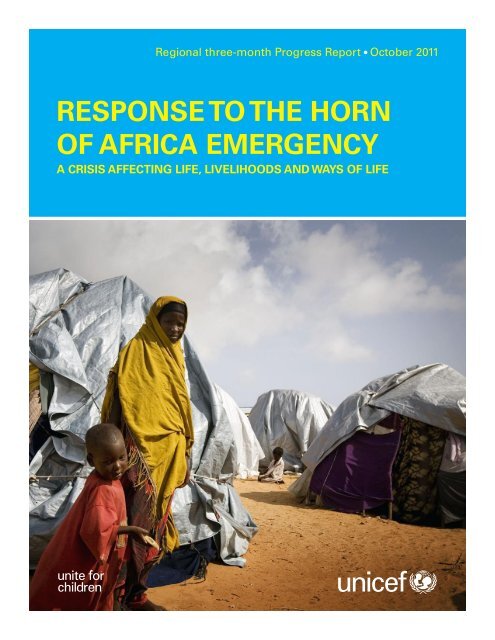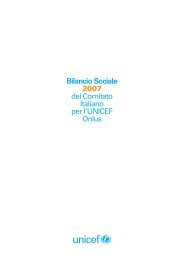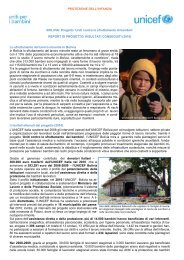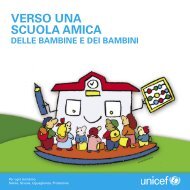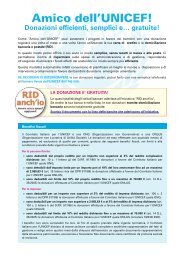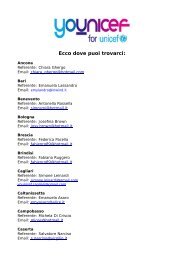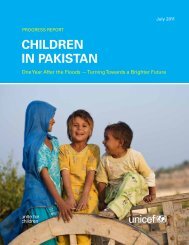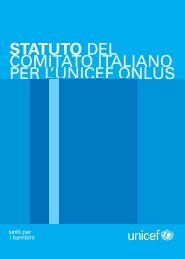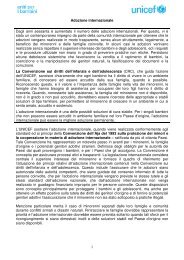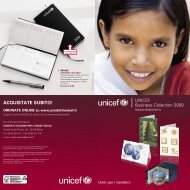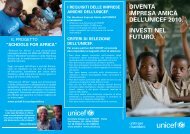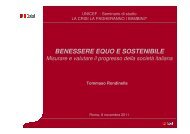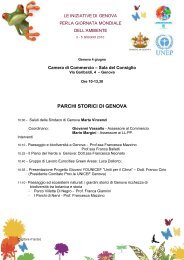RESPONSE TO THE HORN OF AFRICA EMERGENCY - Unicef
RESPONSE TO THE HORN OF AFRICA EMERGENCY - Unicef
RESPONSE TO THE HORN OF AFRICA EMERGENCY - Unicef
- No tags were found...
Create successful ePaper yourself
Turn your PDF publications into a flip-book with our unique Google optimized e-Paper software.
Regional three-month Progress Report October 2011<strong>RESPONSE</strong> <strong>TO</strong> <strong>THE</strong> <strong>HORN</strong><strong>OF</strong> <strong>AFRICA</strong> <strong>EMERGENCY</strong>A CRISIS AFFECTING LIFE, LIVELIHOODS AND WAYS <strong>OF</strong> LIFE
“ The combination of severe drought, soaring food prices and conflict inSomalia has resulted in a humanitarian crisis rarely seen in the Horn of Africa.UNICEF has mounted an unprecedented response to reach children inneed, wherever they are. Nutrition, health, water, sanitation and hygieneinterventions are saving thousands of lives and, together with programmesfor child protection and education, are laying the foundations for a betterfuture.Much more, however, needs to be done to respond to the magnitude of thecrisis. With continued support we can further scale up our interventions in theaffected communities in Somalia, Kenya, Ethiopia and Djibouti. Our combinedefforts will continue to make a difference.“Elhadj As Sy,UNICEF Regional Director for Eastern and Southern Africa& Global Emergency Coordinator for the Horn of Africa Crisis© UNICEF/ESARO/2011/Kun Li
ContentsExecutive summary 4Fast facts 5UNICEF in actionSomalia 7Kenya 13Ethiopia 18Djibouti 23Managing the response 25Resource mobilization 30Looking ahead 32One crisis, many stories 34Partners and counterparts 36Acronyms 38References 39
Executive summaryThis year’s severe drought in the Horn of Africa, combinedwith soaring food prices and the conflict in Somalia,has caused famine in some Somali regions and taken astag gering toll on children. The refugee flow caused bythe dire situation inside Somalia escalated into a regionalcrisis in early July, with hundreds of thousands of peopleon the move, fleeing famine and conflict, into neighbouringcountries. Over 13 million people are in need ofhumanitarian assistance, including some 700,000 Somalirefugees 1 and nearly 1.5 million displaced people insideSomalia. Half of those in need are children.The problemDrought has been recurrent in the region and communitiesare used to adopting coping mechanisms to adapt tothe changing climate realities. The situa tion has becomemore severe in recent years as droughts have becomemore frequent. They now occur almost every other year,leav ing too little time for recovery. Pastoralist and agropastoralist communities in drought-affected areas acrossthe region are facing a rapid deterioration of their livelihoods.In an effort to cope, men are moving on in searchof water and grazing lands to keep their livestock — thefamily’s main asset — alive, while the elderly, womenand children remain behind. Farmers, meanwhile, aretied to their land and have little flexibility to respond tothe progressing drought. This time around, communitycoping mechanisms have been stretched to the maximum,as the impact of a particularly severe droughthas been exacerbated by food price increases of up to250 per cent across the Horn of Africa. In Somalia, thecombination of natural disaster and man-made problemshas resulted in a famine declaration across six areas ofCentral South Somalia.Children are at the centre of this crisis. staying behind inthe worst-affected areas of Central South Soma lia,where an estimated 750,000 could die if humanitarianassistance cannot be scaled up significantly. Somali refugees who have recently crossed theborder into Kenya, Ethiopia and Djibouti in searchof humanitarian assistance. The majority have fledto the large refugee camps around Dadaab in northeastern Kenya and Dollo Ado in Ethiopia, with asmaller number moving to Djibouti. Most of thosewho set out on this risky trek to neighbouring countrieswere women and children, arriving ex haustedand malnourished, sometimes after weeks on theroad. Men and boys often stay behind to take care ofthe remaining animals, and to avoid the risk of beingrecruited into armed groups en route. escalating food prices live outside the camps, in aridand semi-arid lands across the Horn of Africa wherethe impact of the drought threatens their livelihoodsand their whole way of life.The emergency has exacerbated multiple threats forchildren and women as they become weakened byacute malnutrition, threatened by disease aggravatedby lack of access to water and poor sanitation and hygiene,and exposed to increased protection risks. Morethan 320,000 children are severely malnourished, halfof them in Central South Somalia. There are increasingreports of measles cases, and cholera and acutewatery diarrhoea (AWD) are looming threats as theregion awaits the coming rains. Education has resumedfor many children after the hiatus of the school holidays,but is now endangered by the massive migrationof families. Recent assessments show that significantnumbers of girls and women are exposed to sexualviolence during their journeys and on their arrival inovercrowded settlements, as well as to early and/orforced marriage – a coping mechanism used by familiesto protect their daughters.
The responseGiven the recurring drought situation in the Horn ofAf rica, UNICEF had integrated disaster risk reduction— particularly drought mitigation — into its regularprogrammes since the end of 2010 and had acceleratedits response to the effects of the worsening droughtsince the end of 2010. An even worse situation wasaverted across much of the Horn of Africa as systemsand services – such as the UNICEF supported HealthExtension Programme in Ethiopia — were already inplace to mitigate the effects of the drought on the mostdisadvantaged people. With the rapid escalation of thecrisis in mid-2011, UNICEF scaled up operations in allaffected countries significantly. Generous public andprivate funding contributions enabled the rapid expansionof the emergency programmes for famine-affectedpopulations in Somalia; the provision of life-savingservices for thousands of refugees crossing intoKenya, Ethiopia and Djibouti; and the strengthening ofexisting programmes in drought-affected communitiesin Kenya and Ethiopia.UNICEF contributed to the coordination of a collec tiveresponse through leadership of the humanitarian clustersfor the Nutrition, Water, Sanitation and Hy giene,and Education (with Save the Children) sectors inSomalia, and provided technical support to government-ledcoordination in these sectors in Kenya,Ethiopia and Dji bouti, with UNHCR coordinating therefugee response.Three months on from the declaration of famine inparts of Somalia, and UNICEF’s activation of its CorporateEmergency Procedure, the scaled up humanitarianresponse is demonstrating initial results: over 108,000severely malnourished children have been treatedthrough therapeutic feeding centres; hundreds ofthousands of children across the four countries continueto benefit from a range of nutrition and feedingprogrammes; UNICEF has stepped in to fill the gap ingeneral food distribution with blanket supplementaryfeeding programmes in Somalia. Water is now accessibleto 2.2 million people due to the efforts ofFast factsScale and impactassistance across Somalia, Kenya, EthiopiaCentral South Somalia, with the lives of750,000 people at risk by December if reliefmalnourished children in the fourUNICEF response with partners since Julychildren are being treated throughUNICEF’s total funding requirementfor further programme scale-up inSomalia to address nutrition, health,WASH, cash support, shelter and
UNICEF and its partners; 1.2 million children andyoung people had been vaccinated against measlesby end September and immunization campaigns areunderway to protect children from the risk of diseaseduring the coming rainy season; 48,000 children areaccessing Child Friendly Spaces to reduce protectionrisks – heightened when families are forced to migrateand their coping mechanisms are stretched to themaximum – in an effort to provide a safe environment.SUDANSOUTHSUDANUGANDATANZANIAShankoleETHIOPIAKENYA4.5 million262,000NairobiAddis-Ababa3.75 million561,000 DadaabHorn of Africa 3DjiboutiAli-AddahDollo AdoDJIBOUTI120,00019,000SOMALIA4 millionMogadishuIndian Ocean13.3 million inneed of assistanceLocal people in need of assistanceTotal refugee caseloadsThe boundaries and names shown and the designations used on this map do not imply officialendorsement or acceptance by the United NationsThe scale up of the response has been challenged bythe on-going conflict and insecurity in Somalia andparticularly the restricted humanitarian access andlogistical obstacles. In an effort to address some ofthese challenges, the programmatic response hasbeen accompanied by a massive logistics scale-up.Between July and September, 9,740 metric tons (MT)of life-saving supplies were moved to the region fromEurope, Dubai, India and other parts of Asia, includ ing3,901 MT by 113 flights. For Somalia alone, 6,627 MTof supplies were delivered for famine affected childrenby air, land and sea routes. UNICEF built on its continuousoperational presence in Soma lia since 1972 andits existing country programmes with integrated emergencypreparedness and response capacity in Ethiopia,Kenya and Djibouti by bringing in an additional 176surge staff (in addition to the existing 813 staff members)to work through four Country Offices and 17 fieldoffices to strengthen the emer gency response capacity.To achieve the greatest pos sible access to childrenand women in need in Central South Somalia, UNICEFhas worked closely with a range of partners on theground and is working to coordinate improved reachas a member of the Humanitar ian Country team. Theresults included in this report reflect available informationon achievements until the end of Septemberwhile the full impact of the scale-up will be reflected asfurther data become available in the coming weeks.Looking aheadThe emergency interventions have reached thousandsof children and their families to date. However, muchmore must be done — by UNICEF, Governments, UNagencies, NGOs, donors and partners — to furtherscale up and sustain the crisis response, especially inSomalia where the situation continues to deteriorate.While the drought situation for Kenya and Ethiopiahas started to improve due to recent rainfalls, inSomalia the famine is not over and is expected tospread even further by the end of the year without afurther scale up of the response. 2 The coming monthswill be decisive in efforts to avert the death of anestimated 750,000 people, and continuous fundingsupport will be re quired to sustain and further expandoperations until the middle of 2012 at the very least.Above all, the humanitarian community must be enabledto continue to expand its response to save lives.UNICEF and humanitarian partners count on the continuedgenerosity of donors to be able to reach asmany children and families as possible in Somalia andprovide quality assistance to refu gees in Kenya,Ethiopia and Djibouti. Donor support is also vital toour work with government and community part nersin Kenya, Ethiopia and Djibouti to start the transitionfrom the current emergency response to expandeddisaster mitigation efforts to avert future crises. Withcontinued support, more lives and livelihoods will besaved, and ways of life sustained in the Horn ofAfrica’s arid and semi-arid lands.
HealthHealth services in Central South Somalia have beenconstrained, historically, by limited access to facilitiesand, over the last two years, by restrictions on outreachservices. UNICEF’s strategy includes scaling up theexisting health services and increasing outreach and accessthough community-based interventions to addressthe top causes of illness and death in children and toprevent and control contagious diseases. In particular,UNICEF has supported community-case managementof pneumonia, diarrhoea and malaria and the provisionof emergency medical supplies for health centresthroughout Somalia. UNICEF has provided routine andemergency measles and polio vaccines, communica tionstrategies and health education messages, as well asmeasures on preparedness and response to outbreaksof measles, malaria and cholera.Immunization coverage has been severely limited byrestrictions imposed by non-state entities and localauthorities, with preliminary results showing an estimated964,200 children aged six months to 15 yearsreached out of the 2.9 million targeted with measlesvaccinations. Of those, 903,400 children receivedVitamin A supplementation and over 166,800 receivedde-worming medication depending on age groups,while 426,000 children under 5 years received oral poliovaccine. To ensure access for treatment of commondiseases, UNICEF will supply clinics and health postsacross the central south with enough medicines andequipment by the end of October to serve an estimated1.35 million of the 2 million children targeted.UNICEF is also working to prevent or respond to diseasein anticipation of the rainy season. With WHO andpartners, it has focused on developing an action planfor cholera response, procurement of supplies such asdiarrheal disease kits, and supporting coordination andcapacity development of staff from four hospitals and28 maternal and child health clinics in case managementof cholera. But access constraints in Al Shabaabcontrolledareas threaten services and increase the riskof outbreaks, particularly due to the inability to directlyoversee the quality of services at hospital and Maternaland Child Health (MCH) levels.Work on malaria has focused on prevention. It has includedthe provision of 110,000 long-lasting insecticide-treatedmosquito nets to 55,000 households (of the 140,000targeted) and pre-positioning of 50,000 more, as well aspreparedness planning with partners to es timate supplyneeds, procure diagnostic tests, malaria treatment andprevention supplies and to enhance surveil lance.Water, sanitation and hygieneUNICEF and implementing partners have focused onmeeting the water, sanitation and hygiene (WASH)related needs of communities and displaced people,while minimizing the related health risks caused by thedrought and mass mi gration. By end September, aboutone million people (of the 1.5 million targeted over sixmonths) were accessing safe water through a combinationof chlorination, water trucking and constructionor rehabilitation of water sources. Some 55,900 people(of the 150,000 targeted) had new access to sanitationfacilities. A total of 171,100 people have been supportedwith the means to practice good hygiene andundertake household water treatment in Bay, Bakool,Benadir, Lower Shabelle, Gedo and Lower and MiddleJuba. All interventions are also contributing to the responseto control AWD and cholera, especially in areaswith existing, newly arrived and transiting IDPs.Child protectionUNICEF is working with partners to address the arrayof protection concerns for children heightened by thefamine, conflict and displacement. Reintegration programmeshave reached 239 children associated witharmed forces/groups (CAAFG) or at risk of recruitment(out of a targeted 950 children by 31 December 2012) andprovided non-formal education, vocational training, psychosocialcare and support and two meals per day. Theexisting Monitoring and Reporting Mechanism reported306 child rights violations in July and August, the majorityof them consisting of child recruitment (214). Out ofthe 306 cases, 103 children were referred to psychosocialsupport, medical assistance or other services. UNICEF isworking to strengthen the capacity of seven child rightsmonitoring organizations in Mogadishu.
Given the risks to children in mass population movements,UNICEF is supporting partners in an Identification,Documentation, Tracing and Reintegration (IDTR)system for unaccompanied and separated children intransit areas. At the Dobley transit point in Lower Juba— en route to Dadaab —139 separated children and 46 IndicatorsCluster target(people to bereached by endCluster totalUNICEF target(people to bereached by endUNICEF totalNutrition# of children under five with Severe Acute Malnutrition admittedin Therapeutic Feeding programmes# of children under five with Moderate Acute Malnutrition admittedin supplementary feeding programmes# of households reached by enhanced blanket feeding distributions110,000 2 30,615 3 110,000 30,615160,000 76,293 99,000 53,167200,000/month 62,900 4Health# of children 6 ms
unaccompanied children have been registered to date,with information shared on the Kenyan side to expeditetheir transport and access to services.As a multisectoral effort with education and WASH,a total of 194 Child Friendly Spaces (CFS) (out of thetarget 353) have been established in IDP camps, transitpoints and host communities in famine-affectedregions and are currently providing 19,700 childrenwith safe spaces to play and learn and to access safewater and sanitation facilities. The centres also allowfor facilitators to address child protection issues andregister and refer child protection cases.EducationUNICEF supported the reopening of schools inSeptember by providing incentives for over 3,650teachers and distributing enough textbooks for 72,620children (one book for two children) with some alreadydispatched and some arriving in October. This has facilitatedthe enrolment of 321,400 children (48 per centgirls) in over 1,300 schools. Children have also benefitedfrom existing UNICEF-supported WASH facilitiesand supplies from the last school year. School reopeningsin September were met with low enrolmentin all regions with the exception of those in the Afgoyecorridor and Mogadishu, which has seen an influx ofdisplaced children.In addition, some 37,000 children — at least 40 per centof them girls — continued their education during theschool holidays (June-September) through 155 IDPschools, where UNICEF provided supplies and teacherincentives. A rapid needs assessment with cluster partnersin August showed an estimated 200,000 schoolagechildren had moved with the thousands of householdsmigrating to urban areas or across borders.A coordinated responseUNICEF-led clusters (Nutrition and WASH, and Educationwith Save the Children) and clusters supported byUNICEF such as Health and Protection, were operationalbefore the scale-up. All clusters have been activelyworking to establish sub-national cluster coordinators,with WASH and Nutrition appointing focal agencies inmost regions of the Central South. By end of September,UNICEF had 11 cluster-dedicated staff in Nutrition(4), WASH (4), Education (2) and Child Protection (1).The WASH cluster comprises a total of 71 active partners.In Nutrition, UNICEF coordinates the efforts ofover 80 national and international partners across thesouth, while in education there are 50 active nationaland international partners. Thematic working groupswithin the education cluster — each with lead agencies— were formed to consolidate information and harmonizeguidelines.Coordination in all clusters remains limited by the lackof international presence permitted in Al Shabaab-controlledareas, and limited mobility in Mogadishu forUN agencies. Scaling up cluster partners, technicallyand in human and financial resource management,also requires intensive training, dependent on access.Challenges and way forwardThe overall challenge remains finding entry pointsto implement key programmes in a highly restrictedenvironment. The mass displacement has also meantplanning and managing interventions with scarceand/or fluid data on population movements, making itdifficult to determine coverage and impact of interventions.Operationally, Somalia presents a myriadof chal lenges. Extensive negotiations are requiredon every supply movement and clearance from localauthori ties for programme implementation and staffmove ment is granted on a case-by-case basis (sometimesmeaning inspection of supplies by centralauthorities prior to dispatch to final destination).The needs are also outstripping the available transportinfrastructure, with flight cargo insufficient or extremelyexpensive in the early weeks of the scale-up,and humanitarian cargo is now threatening to overwhelmthe capacity of Mogadishu and surroundingports. Ongoing customs and tax waiver negotiationsto expedite the transit goods that need to be repackedfor fast onward transport from Kenya have resulted infurther delays.
Priorities for October-December include addressingrisks anticipated for the upcoming rainy season, byscaling up malaria control programmes including indoorresidual spraying and insecticide-treated plasticsheeting targeting IDP camps, and nets for households.Cholera prevention and response activitieswill continue to be scaled up. A major hand washingpromotion campaign in mid-October is expected toreach over one million people, alongside distributionof household water treatment supplies to at least200,000 people.In education, distribution of textbooks should be completedin October, and emphasis in the coming monthwill be placed on ensuring an integrated package ofhealth, nutrition, WASH and food vouchers throughschools, as well as increasing enrolment whereverpossible. New stocks of teaching, learning and recreationsupplies for 400,000 children are expected toreach schools across the south in the coming months.Denial of outreach campaigns and public advocacy forimmunization in Central South Somalia has made italmost impossible to reach 2.9 million children in needof measles immunization, raising fears for the monthsto come. Mop-up measles vaccinations are plannedin Mogadishu for late October-early November targetingall 16 districts and 750,000 children aged sixmonths to 15 years. They are to be carried out by WHOand UNICEF, with the support of NGOs, and with theCenters for Disease Control (CDC) already on board.Stockpiling and planning is on-going for other regions/districts in the event that access becomes possible, includingone additional location in Lower Juba that hasbeen approved for vaccinations by local authorities,where UNICEF is expecting to reach 43,270 children.By end October, there are expected to be enoughdrugs and supplies in transit to reach 85 clinics and250 health posts – sufficient to ensure access to basichealth care for 1.35 million people.Restricted social mobilization efforts also prevent familiesand children from accessing nutrition services,with only a limited number of people coming to seekassistance at feeding programmes, and quality controllimited by the lack of training opportunities.The nutrition programmes aim to scale up the capacityfor treatment of severely malnourished children toover 18,500 per month and scale up coverage for treatmentof moderately malnourished children. Enhancedblanket supplementary feeding will continue, aimingto reach 200,000 families per month. By November,access permitting, the introduction of a communityhealth worker system in the south should begin toincrease demand for services and to address issuessuch as follow up of defaulters and improved referrals.By early October as mentioned above, a call centrewill be functional to help address the many challengessurrounding partner capacity and reporting from the1,100-plus feeding sites.UNICEF and partners also plan to expand systemsfor unaccompanied and separated children, whileintegrat ing child protection measures and measuresto address gender-based violence (GBV) to mitigatethe heightened risk of violence, abuse and exploitationthrough entry points such as Child Friendly Spacesand nutrition and health centres. The Cash programmeis anticipated to reach 40,000 households by endOctober as access negotiations, beneficiary registrationand preparations on site are scaled up.FundingFunding GapFunding Received
UNICEF Emergency ActionKENYAResponse to date© UNICEF Kenya/2011/Riccardo GangalIn Kenya, successive seasons of poor rains haveresulted in multiple crop failures and loss of livestock,destroying livelihoods. Coupled with risingfood and fuel prices, an estimated 3.75 million peopleare in need of food assistance, mostly in the northernregions of Turkana, Wajir, Mandera, Isiolo, Marsabit,West Pokot and Moyale, but also in the southeast(Ukambani) and coast following 80 per cent cropfailure. On May 30, 2011, President Kibaki declaredthe drought a national disaster. Access to water inmany of these drought-affected areas is becomingcritical, resulting in increasing pressure on remainingsources and further exacerbating tensions over rightsof access. Incidence of acute watery diarrhoea (AWD)have been increasing steadily over past months, andmeasles outbreaks have been reported.Simultaneously, tens of thousands of refugees havefled drought, armed conflict and famine in Somalia,adding to the 20-year-old, already teeming campsaround Dadaab, some 98 km from the Kenyan-Somaliborder. For many Somalis, and especially children andwomen, the route to the border in Somalia and thenthe trek to Dadaab presents a gauntlet of protectionconcerns, including family separation, gender-basedviolence and abduction by armed groups – asidefrom basic survival challenges related to health andnutrition. The policies of the Government of Kenya tominimize and dissuade a further influx of Somali refugeesinto the country has resulted in the original threeDadaab camps being stretched beyond their initial capacity,with two new camps in the process of opening.The refugee population in Dadaab — with an initialcapacity to house 90,000 people — and its surroundinghas topped 450,000, 4 including an estimated 100,000who have arrived since 1 June. Congestion has createdthreats to women and children’s health, educationand protection.UNICEF’s humanitarian response has focused onthe rapid scale up of pre-existing systems and programmeswith Government and partners. Nineteenstaff members and 14 standby partners were deployedby the end of September. This includes added capacityfor cluster/sector coordination arrangementswhere UNICEF has a co-lead responsibility with theGovernment (WASH, Nutrition, Education, and ChildProtection). An emergency hub has been establishedin Lodwar, Turkana and a field office has been set upin Dadaab. Eleven new partnerships have been formedwith NGOs and health surveillance was improved indrought-affected areas with increased staffing throughthe Government’s Provincial health system. Rapid responseteams were established and supported for improvedmonitoring and timely repair of water sources.Systems to address separated and unaccompaniedchildren have been significantly scaled up and procurementhas been initiated for substantial supplies inall sectors.
Responding to immediate needsNutritionDrought-affected areasUNICEF has responded to the crisis by accelerating thescale-up of high impact preventive and curative interventions,including management of acute malnutrition at communityand health facility level. In July and August, some11,900 severely malnourished children (49 per cent of thetarget) had been admitted to the therapeutic feeding programme.Admissions have also been high for ModerateAcute Malnutrition (MAM), with 33,100 children under five(42 per cent of the July – December cluster target) admittedto supplementary feeding programmes since July 2011.Refugee campsUNICEF has extended its technical support to NGOpartners through UNHCR to scale-up nutrition activities,particularly treatment of severe and moderate acutemalnutrition. Through three stabilization centres, 16 outpatienttreatment centres and 15 supplementary feedingcentres, 6,700 severely malnourished children have beenadmitted in July and August, with 13,980 were admittedin 2011 to date. 5 Caseloads have also been high formoderate acute malnutrition, with 11,700 children underfive (81 per cent of the target) admitted to supplementaryfeeding programmes in Dadaab in July and August.HealthDrought-affected areasUNICEF has strengthened immunization coverage,emphasizing measles and polio, and scaled up maternal,new-born and child health activities at facility and communitylevel. Preventive integrated measles campaignshave been delayed by response to the recent Wild PolioVirus (WPV) outbreak in Nyanza province, though surveillancesystems have been strengthened in these areasto ensure early detection of cases and early warning ofpossible disease outbreaks. A WPV-measles campaign isdue to commence in October. Routine immunization wasweak in many of the affected areas, but the scaling up ofintegrated outreach services has improved overall coveragefrom 42 per cent at the start of August to 46 per cent(39,900 children under one) by the end of the month.Refugee campsVaccination and Vitamin A campaigns have been providedfor refugee and host communities to prevent diseaseoutbreaks in and around the overcrowded camps. UNICEFhas worked with UNHCR and the Kenya Provincial HealthAuthority in border areas to provide health stabilizationsupport to refugees on arrival. Measles immunizationshave reached 67,800 children under five in Dadaab and103,000 children under five in host communities surpassingtargets and the benchmarks set by the CoreCommitments to Children in Humanitarian Action (CCCs).As refugee inflows increased, similar rates were reachedfor polio vaccina tions (75,100 children under five in campsand 114,000 in host communities) and Vitamin A (68,000children under five in camps; 99,900 in host communities).Water, sanitation and hygieneDrought-affected areasUNICEF is supporting partners to reach 936,000 peopleincluding approximately 514,000 children — out of theoverall cluster partner response of 1.63 million — withaccess to safe water or water sources through a combinationof boreholes, wells, water trucking and installationand rehabilitation of water systems. In support of thenutrition response, 260,000 families with malnourishedchildren have been supported with the means to practicegood hygiene and undertake household water treatment.In addition, water supplies and sanitation facilities havebeen repaired or installed in 64 health facilities implementingnutrition programmes. In partnership with the DistrictHealth authorities and NGO partners, 1.3 million peoplehave been reached through rapid hygiene promotionactivities. In addition, UNICEF has been working with partnersto ensure safe water supply and sanitation facilities in154 schools, benefitting approximately 57,000 children.Refugee campsIn close collaboration with UNHCR, the UNICEF WASHresponse has focused on providing refugees with accessto safe water in transit to camps or within host communities.By September, at least 10,000 refugees had accessto safe water en route to Dadaab through the installationof 16 strategic water points. This figure has been fallingsince August with the advent of transport organized forrefugees between Liboi and Dadaab. These water points
also benefited some 122,500 people in the host communities.Some 18,000 refugee families (about 90,000people) living in makeshift shelters around the maincamps were benefiting from UNICEF WASH suppliesand hygiene promotion activities.Child protectionDrought-affected areasExisting programmes in drought-affected areas havebeen expanded to meet the growing need for servicesas livelihoods and coping mechanisms deteriorate. Atotal of 1,089 children were reached through UNICEFsupportedchild protection centres in Garissa and Eldoretto provide psychosocial and medical support, sportsand recreational activities, reintegration of separatedchildren with their families and training of communitychild protection committees. A $3.5 million cash transferprogramme is expected to cover 12,000 households bythe end of October and, with the Child Welfare Societyof Kenya, UNICEF is expanding the separated childrenprogramme established in 2008 to reach at least 1,000unaccompanied and separated children and child headedhouseholds. UNICEF has also partnered with theEx-Street Children Community Organization (ECCO) inEldoret to deliver services to street children.Refugee campsUNICEF has worked to strengthen child protectionmechanisms in camps, at border reception centres andin host communities. By end August, some 27,600 childrenbenefitted from Child Friendly Space in Dadaaband surrounding areas. Psychosocial specialists wereplaced in camps to improve service delivery. Newmeasures to address separated and unaccompaniedchildren include fast-track procedures introduced inAugust to reduce the registration wait for vulnerablegroups from 3-4 weeks to 1 day. This is in additionto services and treatment provided to those in need.A total of 46 separated or unaccompanied childrenidentified were unified with families or provided withalternative care. As part of the response to reports ofincreasing sexual and gender-based violence inSomalia and en route to Dadaab, UNICEF worked inclose collaboration with UNHCR, Save the Children,CARE, and IRC to conduct a rapid GBV assessment inthe refugee camps and in the surrounding areas.UNICEF liaised with IRC to supply safe spaces withtents for women and girls to access services andreceive information and support. UNICEF is also supportingIRC on providing ‘dignity kits’ for women andgirls, including whistles, buckets and feminine hygieneitems. In addition, UNICEF and partners have initiatedprotection monitoring activities at the border areabetween Kenya and Somalia and are facilitating accessto available services in the camps for the displacedpopulation, in particular GBV survivors. Indicators Drought response Refugee responseCluster target(people to bereached by endCluster totalUNICEF target(people to bereached by endUNICEF totalUNICEF target(people to bereached by endUNICEF totalNutrition 2# of children
Health# of children
EducationDrought-affected areasFollowing a joint assessment with education clusterpartners and the Ministry of Education in droughtaffectedareas, UNICEF, cluster partners and WFPadvocated to keep schools open during the Augustholiday period to ensure continued learning andallow 1.2 million children to access one meal a day.UNICEF supported access by providing 63,500 childrenwith education supplies, boarding school suppliesor mobile school kits.Refugee campsUNICEF has enabled children to continue educationthrough the provision of teaching and learning materials— including textbooks for 55,500 children — and30 tents that have provided classrooms for 2,700 children.UNICEF is working with partners to constructsemi-permanent schools and Early Childhood DevelopmentCentres allowing 12,000 children aged 3-13years to continue learning, including 9,000 primaryschool-age children.A coordinated responseWith coordination at the government level, UNICEF hasbeen co-leading sector working groups in Nutrition,WASH and Education (with Save the Children) and supportingworking groups in Child Protection and Health.UNICEF and its standby partners have provided or cofundednine cluster staff for coordination or informationmanagement: Nutrition (1), WASH (5) and Education (3including a coordinator co-funded with Save the Children).All coordination structures were in place beforethe crisis, but have been intensified since the declarationof a national disaster. In WASH, information managementstructures – including online reporting – built oninvestments from past emergencies with dedicated capacity.Under the WASH Cluster, an inter-cluster HygienePromotion Working Group has been established, bringingtogether representatives from Health, Nutrition, Educationand WASH sectors. The education cluster partnersdeveloped a schools database for 39 arid districtscovering 387,000 students. Coordination of the responsefor all refugees, in particular in the Dadaab camps, ismanaged by UNHCR as the lead agency, with UNICEFproviding programmatic support in various sectors.Challenges and way forwardThere are early signs of improvements in the nutritionsituation in drought-affected areas, which is expectedto continue in the coming months given a continuedstrong food security response. New admissions in specializedfeeding programmes had decreased to 5,560by end August from 6,379 in June. In both Dadaab andNorthern Kenya, medical supplies have been prepositionedto meet possible outbreaks of epidemics,including cholera and measles. An expanded communityhealth system covering the Dadaab refugee campwill be scaled-up. The number of people with accessto safe water is expected to increase by 50,000 byOctober 2011. Twenty-six more schools on the schoolfeeding programme will have access to WASH facilitiesin support of safe school feeding practices. Additionaleducation supplies will support school access for26,400 more children. The number of children accessingChild Friendly Spaces is expected to rise from27,600 to 50,000 in October.The greatest challenge has been scaling up operationsto match the caseloads, in particular capacity forthe responses to nutrition and gender-based violence.Immunization campaigns remain critical as low immunizationrates among incoming refugees pose threatsof measles outbreaks in camps especially. For WASHprogrammes, finding sustainable solutions to the longtermwater access issues and the extremely high levelsof open defecation in the drought-affected areas is amajor challenge.FundingFunding GapFunding Received
UNICEF Emergency ActionETHIOPIAResponse to date© UNICEF/NYHQ2011-1329/Indrias GetachewIn Ethiopia, the failed seasonal rains of October-December 2010 in the southern and south-easternparts of the country were followed by poor rainsin February-May 2011 in major parts of the SomaliRegion; Southern Nations, Nationalities, and People’sRegion (SNNPR); and Oromiya Region. The combinedeffects of drought, food price increases, and insufficientresources for preventive measures have resultedin increased malnutrition among children. Admissionsto therapeutic feeding centres were alreadyhigh between March and April. By July, a multi-agencyassessment led by the Government of Ethiopiafound 4.5 million people in need of food assistance, a42 per cent increase from April. This included 159,000children 6 projected to suffer from severe malnutritionby the end of December. The UNICEF response to theemergency has been on-going since November 2010,when the situation started to deteriorate.The response has benefited from Ethiopia’s establishmentof systems to address vulnerability at communitylevel including the Productive Safety NetProgramme (PSNP), the Health Extension Programmeand a network of mobile health and nutrition teamssupported by UNICEF and NGOs.Ethiopia is responding to humanitarian requirementsin drought-affected parts of the country as well asto refugees from Somalia crossing into the country.Since January 2011, more than 80,000 refugees havearrived into Ethiopia from Somalia, settling in campsin the Dollo Ado area of Ethiopia’s Somali region.During July, the number of refugees crossing per dayreached 2,000, resulting in significant strains on basicservices also used by host communities facing theconsequences of drought. According to UNHCR, asof 20 September 2011, 183,000 Somali refugees areliving in camps in Ethiopia, including some 123,000 inDollo Ado. Mortality rates have been alarmingly highamongst new arrivals. More than 80,000 (68 per cent)of the Somali refugees registered in the four campsare under 18 years old.Responding to immediate needsNutritionDrought-affected areasUNICEF support to Ethiopia’s response to acute malnutritionhas focused on community-based managementthrough the government’s Health Extension Programmeand with the assistance of NGOs. The government’sdecentralized approach to the managementof severe acute malnutrition continues to expand,reaching over 96 per cent of hotspot food insecuredistricts with UNICEF providing technical assistanceand training, and as the main supplier of Ready-to-UseTherapeutic Food (RUTF) and other materials for usein the feeding sites. In the first half of 2011, 157,400children under five with Severe Acute Malnutrition
(SAM) were treated in six drought-affected regions. InJuly and August, 54,600 children under five with SAMwere admitted in therapeutic feeding programmes.In addition, total exits in July and August showed anaverage recovery rate of 86 per cent and mortality rateof 0.4 per cent, exceeding the national and Sphere(international) standards for recovery, and mortalityrates which are above 75 per cent and less than 10 percent respectively.Refugee campsSince July 2011, UNICEF has deployed one nutritionspecialist to Dollo Ado to provide technical supportto UNHCR and other partners in responding to theemergency nutrition situation. UNICEF has supportedpartners in Dollo Ado with essential nutrition suppliescontributing to the treatment of complicated cases ofsevere malnutrition (a forthcoming UNHCR weeklysystem will provide data on admissions). A UNICEF assessmentof Infant & Young Child Feeding (IYCF) practicesin September concluded that the high levels ofinfant mortality and malnutrition in camps are linkedto poor breastfeeding practices, among other causes.Subsequently UNICEF immediately trained 14 professionalsfrom Government and NGOs in IYCF. Additionalcapacity will be mobilized in October with Save theChildren US, ACF and other NGOs establishing BabyFriendly Spaces to address breastfeeding practices.HealthDrought-affected areasMobile Health and Nutrition Teams (MHNT) havereached out to pastoralist populations, conducting11,800 consultations, including 4,600 children underfive, in July and August. 7 This follows over 130,000consultations including 46,000 children under five inthe first half of 2011 in the Somali and Afar regions.UNICEF also provided supplies to 18 INGO-managedMHNTs, which conducted an additional 18,800 consultationsincluding 6,200 children under five in Julyand August, 8 UNICEF provided essential drug kits tohealth facilities covering a total population of five million,including 750,000 children under five. UNICEFwith the Ministry of Health and partners supported asub-national measles campaign targeting 6.9 millionchildren six months to 14 years in 134 drought-affectedworedas. The campaign began on 25 September andreached 71,200 children in the first week. Since July2011, UNICEF has provided technical assistance andsupplies to support the response to seven suspectedAWD outbreaks in four regions: Dire Dawa, Harari,Oromiya and Somali. Timely response and preventionefforts have kept the case fatality rate below one percent in all outbreaks.Refugee campsFrom April 2011, UNICEF has supported measles androutine vaccinations for all new refugee arrivals duringregistration. Since July, some 35,000 childrenaged six months to 15 years (96 per cent coverage asper post campaign surveys) 9 were vaccinated. In lateAugust, UNICEF deployed two MHNTs to Dollo Adorefugee camps to support primary health interventionsby UNHCR, government and other implementingpartners. These two MHNTs have conducted 1,400consultations, screened 1,600 children for malnutritionand arranged more than 100 referrals in one month ofdeployment.Water, sanitation and hygieneDrought-affected areasSome 67,000 people (67 per cent of the target) —including 10,700 children under five — have beenreached with water trucking operations since 1 July.About 195,000 people (31,200 children under five)were reached between November 2010 and June 2011.Continued support for the inspection, rehabilitationand expansion of water sources, particularly in theSomali Region, has ensured a sustained water supplyfor an estimated 278,000 people since July, including44,480 children under five, and secured adequatesupplies for water trucking. Some 347,000 people (112per cent of the target), including 55,520 children underfive, were reached with water treatment chemicals fortwo months of use. This figure includes those affectedby drought and those exposed to the risk of AWD. Anestimated 2,575,000 people, including those affectedby drought and those at risk of AWD and participantsin five major religious gatherings in Amhara andOromiya regions, received critical hygiene and related
information. In addition, 245 out of 256 targeted healthfacilities (96 per cent of the target) were provided withWASH packages comprising water tanks, jerry cans,treatment chemicals and sanitation squatting plates.Refugee campsSince July 2011, UNICEF provided technical support,specialist equipment and critical WASH supplies toUNHCR, IRC and other partners in Dollo Ado. Interventionsinclude water trucking in Kobe camp undertakenby IRC, and reaching an estimated 16,600 peopleincluding 5,000 children under five (67 per cent of thetarget). UNICEF, also through partnership with IRC,is establishing a piped water supply to serve refugeesin Kobe camp. This will be completed in aboutfour weeks. Water trucking operations continue in theinterim. Based on UNHCR-led assessments in refugeecamps in Dollo Ado and Benishangul Gumuz, UNICEFprocured and delivered nine water treatment kits,pillow tanks, water storage containers and soap. Thewater treatment chemicals alone are sufficient for apopulation of 27,000 people. In terms of hygiene, UNI-CEF developed, refined, and provided communicationmaterials on health seeking behaviours, toilet usageand hand washing to UNHCR and partners for disseminationin Somali camps. To date an estimated 85,400people (69 per cent of the target) have been reached.UNICEF has also supported sanitation by providingtechnical support and two excavators to UNHCR, thelatter to assist in pit toilet construction and pipe laying.The equipment should enable full coverage (currently75 per cent).Child protectionDrought-affected areasPrior to July, and building on longer-term work in theTigray Region, regional government bureaus withUNICEF enabled 150,000 people in 30 drought pronekebeles (communities) to access community carestructures working to prevent and address vulnerability,abuse and exploitation. An additional 50 kebeles(with training of para-social workers) are planned to bereached in Oromiya, SNNPR, and Somali regions, followingan exposure visit for government staff to Tigrayin September.Refugee campsUNICEF and UNHCR developed a VerificationAction Plan and a screening tool to identify andscreen unaccompanied minors and separated children.The verification exercise began in Bokolmayocamp on 13 September and was conducted bySave the Children-US (SCF-US) and UNHCR, withsupport from UNICEF. UNICEF will provide trainingto UNHCR, ARRA and SCF-US on the identification,documentation, tracing and reunification (IDTR)forms and key principles of interviewing children.Meanwhile, UNICEF has provided technical supportto Save the Children-UK on the reunificationof, or alternative care for, 833 unaccompanied andseparated children. UNICEF, UNHCR and SCF-USconducted a joint inter-agency child protectionrapid assessment from 31 August to 3 Septemberin all refugee camps and transit centres. UNHCR,UNICEF and IOM are preparing training on the preventionof sexual exploitation and abuse trainingfor all humanitarian agencies in Dollo Ado, whichis due to start in early October.EducationDrought-affected areasSince the end of 2010, UNICEF worked to strengthenaccess to and quality of education, undertaking anassessment of learning spaces, with a focus on themost vulnerable districts, and providing educationsupplies to 28,000 children, including 13,250 girls.Family movements in search of pasture for animalsand drinking water had forced children to drop outof school and led to school closures before the endof the previous academic year (May/June 2011) inparts of the Oromiya and Somali Regions. In preparationfor the start of the school year in September/October 2011, UNICEF pre-positioned educationmaterials in drought affected regions to benefit over26,000 children 4-18 years old. A training of trainers(<strong>TO</strong>T) on Education in Emergencies reached 35 professionalsfrom the Ministry of Education and othercluster partners. An additional <strong>TO</strong>T was delivered to80 teachers to reach hundreds of other teachers andnon-qualified teaching personnel in communities affectedby drought.
Refugee campsIn advance of the 10 October school start date, UNICEFdelivered tents, recreational, early childhood developmentand hygiene kits to support 11,500 refugeechildren through eight child friendly learning spaces.In addition, education supplies for 20,000 childrenreached Dollo Ado camps. Ethiopia’s Administrationfor Refugee and Returnee Affairs (ARRA), UNICEF andpartners will begin teacher training for more than 100teachers for the Dollo Ado camps in early October. Drought responseRefugee responseIndicatorsCluster target(people to bereached by endCluster totalUNICEF target(people to bereached by endUNICEF totalUNICEF target(people to bereached by endUNICEF totalNutritionChildren
A coordinated responseThe overall responsibility for coordinating emergencyprevention, preparedness and response activities restswith the Disaster Risk Management and Food SecuritySector (DRMSFSS) of the Ministry of Agricultureand Rural Development, and the relevant line ministriescoordinating activities in their sectors. UNICEF,as cluster lead in Nutrition and WASH and co-leadin Education and Child Protection, provides supportto sector coordination. In nutrition, UNICEF has prioritizedstrengthening the government’s EmergencyNutrition Coordination Unit (ENCU), housed within theDRMFSS. The ENCU, comprised of four staff secondedby UNICEF at the federal level including a nutritioncluster coordinator and eight staff at the regional level(SNNPR, Oromiya, Somali and Amhara), has been supportedby UNICEF for the past 11 years.Due to the deterioration of the nutrition situation inthe Somali region, UNICEF recruited an additionalnutrition cluster coordinator for the region in June2011. As the cluster lead for WASH, UNICEF is cochairingthe Federal and Regional WASH EmergencyTask Forces with the Government and, since theonset of the current drought in November 2010, hasadded six national and one international WASH consultantsin five regions. All but one are embeddeddirectly in regional Government to strengthen sectorcoordination directly and to build capacity.Coordination in the Dollo Ado refugee camps is managedby UNHCR with Ethiopia’s national refugeeagency ARRA.or erratic rains, however, would make a further deteriorationmore likely in the Somali Region.Priorities for October-December in drought-affectedareas include: completing/ continuing vaccinationcampaigns while maintaining access to health servicesin areas where the drought crisis is anticipatedto deteriorate further (or where rains may bring newpublic health threats); expanding with partners thenumber of therapeutic feeding centres and the capacityto support them; strengthen water suppliesto drought-affected and refugee communities andprovide supplies and information for hygiene andsanitation; scale up education through the provisionof supplies to school children affected by the droughtand the strengthening of the capacity of teachersand communities; and strengthen regional and subregionalcommunity care structures to monitor, reportand respond to child protection issues.In the Dollo Ado camps, the priorities are to continuewith decentralization of health and nutrition services,improve access to sanitation, get more children intoschools and support the tracing and reunificationprocess and the establishment of more child friendlyspaces. Challenges include maintaining good access inthe Somali Region, ensuring the sustainability of strategiesin the pastoralist areas of the country and raisingresources for programmes that deal with structuralapproaches to resilience including the UN Joint Programmeon accelerating development in the pastoralistDeveloping Regional States.FundingChallenges and way forwardWith good rains in the highlands and the start ofthe harvest, there has been a drop in the number ofcases of severe acute malnutrition registered for threemonths in a row in the country’s biggest regions. Inthe lowlands, however, the country is waiting for theOctober rains, which would bring immediate relief interms of access to water and pasture for livestock. LateFunding GapFunding Received
UNICEF Emergency ActionDJIBOUTIResponse to date© UNICEF/NYHQ2011-1352/Najwa MelekiThe 2011 lean season in most of the pastoral areasof Djibouti began two months earlier than usual,in April. Four consecutive poor rainy seasonshave devastated livestock holdings, withered locallivelihood systems and left 120,000 people in need ofhumanitarian assistance.The drought has been compounded by increased pricesof staple foods, which continue to exceed the purchasingpower of poor urban and rural households. Water,too, is scarce in most pastoral areas.As the drought intensified, the nutrition status of pastoralistchildren in Djibouti — as in Somalia, Kenyaand Ethiopia — deteriorated as a result of the lack ofmilk, the main source of food for chil dren under five atthat time of year.The food security situation in urban areas is also criticaldue to high food prices, reduced employment andlimited petty trade activities, coupled with lack of accessto potable water.Beyond the initial results reported here, UNICEFhas focused since July on strengthening systems forbetter coordination of humanitarian response,including establishment of the nutrition cluster,support to the Ministry of Health for the HealthInformation Management System and to the NationalNutrition Programme.Responding to immediate needsNutritionWith the nutrition situation deteriorating, a community-basedactive case screening, management and datareporting system has been put in place. The admissionsin feeding programmes have increased significantly.From July to end September, the number of childrenunder five being treated for severe acute malnutritionrose from 2,400 to 4,500 (93 per cent of the target),with Moderate Acute Malnutrition (MAM) rising from12,600 to 16,100 children (89 per cent of the target). Tostrengthen monitoring of recovery and mortality rates,UNICEF is supporting the provision of mobile phonesin 30 previously unconnected rural health posts toenable regular monitoring and technical assistance aspart of a nutrition/health surveillance system.HealthMeasles campaigns following an outbreak in Yobokireached 3,150 children aged nine months to 15 years.This was combined with provision of nutritional supplementsfor children under five with severe or moderateacute malnutrition and hygiene promotion.Water, sanitation and hygieneBy end September, some 84,700 people in the most
affected areas were being reached by water trucks ona daily basis, while hygiene promotion campaignswere targeting 6,900 people in the rapidly deterioratingperipheral areas of Djibouti City. UNICEF contin uesto work on the construction and rehabilitation of waterpoints in affected regions and schools for the use ofcommunities and their livestock, as well as the rehabilitationof household latrines.Child protectionA Conditional Cash Transfer programme has benefitted700 Orphans and Vulnerable Children (OVCs) sinceAugust 2011, as an incentive for families to supportfood, clothing, school and health care for such children.More specifically, clothes and school kits wereprovided to enable the OVCs to remain in school.A coordinated responseUNICEF leads the Nutrition cluster, and is working withpartners to jointly develop operational guidelines onthe use of supplementary feeding for children aged six IndicatorsNutritionChildren
Response to dateMANAGING <strong>THE</strong><strong>RESPONSE</strong>© UNICEF Somalia/ 2011/MorookaCoordinating for resultsGuided by UNICEF’s Core Commitments for Childrenin Humanitarian Action (CCCs), Country Offices in theHorn had been accelerating the response to the effectsof the worsening drought since the end of 2010. Therapid escalation of the crisis in mid-2011 required anorganization-wide engagement. On 21 July, the dayafter the threshold for famine was crossed inSomalia, and following a mission to Turkana – one ofthe hardest hit areas in Kenya – Executive DirectorAnthony Lake activated UNICEF’s Corporate EmergencyProcedure for the multi-country Horn of Africa crisisresponse. The procedure triggered the mobilization ofcorporate capacities in support of country office responseefforts – UNICEF offices across the globe wererequested to mobilize. Elhadj As Sy, UNICEF’s RegionalDirector for Eastern and Southern Africa, was appointedUNICEF’s Global Emergency Coordinator (GEC),responsible for ensuring coordinated emergency managementacross the four countries, through mobilizingand coordinating all in-country support; immediatelydeploying additional experienced staff; and implementingsimplified standard operating procedures.UNICEF contributed to the coordination of a collectiveresponse through leadership of the humanitarian clustersfor the Nutrition, Water, Sanitation and Hygiene,and Education (with Save the Children) sectors inSomalia, and technically supported the governmentledcoordination in these sectors in Kenya, Ethiopiaand Djibouti. Somalia (since 2006), Ethiopia (since2007) and Kenya (since 2008) have been applying thecluster approach of coordinated humanitarian assistancefor several years, while the UN Country Team(UNCT) in Djibouti activated the cluster approach inAugust 2011. UNHCR coordinates the sectoral responsesin the Kenyan refugee camps around Dadaab, whilethe Ethiopian government leads response coordinationin the Dollo Ado camps with support from UNHCR.Human resourcesUNICEF, through its Country Offices and Eastern andSouthern Africa Regional Office, had been respondingto the drought for much of the past year. But the deepeningdrought, the declaration of famine in Somalia andthe activation of the Corporate Emergency ActivationProce dure increased the human resources mobilizedfor the response. From 1 July to 30 September,UNICEF surged 176 personnel to support the fourCountry Offices and Regional Office, including 68 forSomalia, 23 for Ethiopia, 31 for ESARO, 53 for Kenyaand one for Djibouti. By end of September, 113 additional‘surge’ personnel were on the ground supporting theresponse, in addition to the 813 regular staff in the fiveoffices. Eighteen staff were surged specifically to helpUNICEF fulfill its accountability as Cluster Lead Agencyin the relevant countries, including 13 for WASH and sixfor information management.
Activating the ‘Rapid Response Mechanism’ procedures— a regional instrument to surge qualified andpre-screened staff from the Region for up to threemonths — UNICEF Country Offices throughout the regionre sponded rapidly to the need for additional staff.Most responded within 24 hours, providing a total of39deployments. UNICEF also facilitated the rapid deploymentof 28 additional staff members from around theworld. Standby partners deployed 28 personnel andUNICEF’s National Committees seconded four staff.UNICEF also ensured its procedures were responsive tothe needs, recruiting vacant regular posts on an ’emer-gency basis’ using fast track recruitment procedures,and hiring short-term technical staff. Headquartersfast-tracked recruitment of 19 international professionalposts while the Regional Office approved appointmentsof 11 National Professional Officers using the samemechanism.In addition, the need to create regular posts to addresslong term needs was addressed through an emergencyPBR/budget planning exercise, which resulted in the establishmentof 38 new positions for Somalia, Kenya andEthiopia Country Offices to complement existing staff.UNICEF Surge capacity20018016014012010080604020001-Jul 15-Jul 29-Jul 12-Aug 26-Aug 09-Sep 23-SepCumulative deploymentsOn the groundTotal response
SecurityHumanitarian response across the Horn of Africa hasbeen complicated by varied security concerns.Somalia continues to be characterized by armed conflict,terrorism, crime, targeted killings and civil unrest.Most of Somalia remains at a high to extreme securitylevel (SL5-SL6 with SL6 as the highest security level).After the famine declaration in July, there was somediscussion by Al Shabaab on facilitating greater ac cessfor aid agencies into areas under their control. This,however, proved futile and the risk to humanitarianactivities remains high. Since the claimed withdrawalof Al Shabaab from Mogadishu on 6 Au gust, six explosionshave been reported in the capital, with the latestattack on 4 October reportedly killing more than 100people and injuring over 100. Al Shabaab hostilityextends to anti-Al Shabaab areas of the Bakool regionand Dobley.Much of Central South Somalia still remains unreachableby previously suspended agencies. UNICEFcontinues to engage in negotiations with various localauthorities, and access has improved in Gedo, parts ofLower Juba, and Bay, but the situation remains highlyvolatile and unpredictable. Despite increased securityin Mogadishu, the influx of IDPs coupled with persistentmilitant elements continues to pose threats andplace new strains on overstretched resources.Since August, there has been an upsurge of securityincidents in Kenya, and many of the most affectedareas across the North and North Eastern parts of thecountry are classified a moderate security level (SL3),limiting UN staff to the implementation of critical humanitarianoperations. The country is grappling with avariety of concerns including: armed conflict along theborders; direct terrorism threats against internationalinterests; increased crime and car-jackings by armedbandits and runaway soldiers; and strained inter-clanrelations across the North.Ogaden National Liberation Front (ONLF) rebel activitycontinue to be of primary concern, with one UN staffhaving been killed and two abducted in May. AlthoughUNICEF’s operations continued without interruptions,proper monitoring and the timely delivery of aid hasbeen reduced due to access constraints.In Djibouti access to the north-western parts of thecountry is particularly difficult, with areas of the regionbeing consider a no-go-zone for UN agencies. Acrossmuch of the affected area, and particularly near theEthiopian border, access is severely obstructed by thelack of developed infrastructure and road networks.Supply and logisticsThe procurement and distribution of supplies has beena key element of UNICEF’s response to the Horn ofAfrica (HoA) crisis in Kenya, Somalia, Ethiopia andDji bouti. During the first half of the year, CountryOffices initially responded by using and distributingsupplies from contingency stocks. Following thedeclaration of a Level 3 Corporate Emergency in July,each Country Office prepared a 180-day supply planto facilitate a procurement strategy and enhance themonitoring of all supply inputs as part of the emergencyresponse.Amount in US$Supplies Ordered for the HoA (in US$) local and offshore$40,000,000$35,000,000$30,000,000$25,000,000$20,000,000$15,000,000$10,000,000Somalia $34MKenya $9.5MIn the Somali region of Ethiopia, where the majority ofcamps are based, the context ranges between a moderateto high security level (SL3-SL4). Clan conflict and$5,000,000-Jul-01Jul-29Aug-18Aug-31Sep-06Sep-13Ethiopia $6.1MDjibouti $378,251Sep-20Sep-22Sep-30
To date, UNICEF (Kenya, Somalia, Ethiopia andDji bouti) has purchased a total of $50.2 million worthof supplies. More than three-quarters of these supplieswere procured offshore, where the main suppliersfor supplementary and therapeutic foods are based.Although the cost of air freight is 10 times higher thantransporting freight by sea, air freight was essential inAugust and September to deliver life-saving suppliesto the region as quickly as possible while sea freightwas en route and UNICEF worked to establish a seacorridor. In addition to the cost of supplies, UNICEFspent $9.7 million on freight alone from 1 July through28 September.UNICEF Supply Division in Copenhagen facilitatedthe overall coordination of offshore procurement andchartering of emergency supplies (supplementary andtherapeutic foods). Between July and September, 113flights and 39 vessels were chartered by Supply Division,carrying the equivalent of 9,740 MT of essentialsupplies via Mombasa, Nairobi and Addis Ababa. Significantin-kind assistance was received from differentpartners, which allowed the airlift of 491 MT of supplies.Supply and logistics surge support – includingfrom standby partners – was provided to the Somalia,Kenya and Ethiopia offices.HoA HoA Emergency Emergency Supplies supplies(Somalia, Kenya, Ethiopia, Djibouti)The greatest scale up has occurred in the CentralSouth Zone (CSZ) of Somalia; from 1 July to 7September, UNICEF has transported a total of 6,627MT of supplies to southern Somalia; by road (70trucks), air (70 flights) and sea (seven shipments).Since July, UNICEF has scaled up the average numberof flights into Somalia from three per month to one ortwo per day. To reduce the time needed from requisitionto dispatch to partners inside Somalia (average 22days) UNICEF is exploring the possibility of deliveringdirectly to partners for their onward distribution tobeneficiaries in targeted locations. UNICEF is also routingsome of the bulk volume sea shipments via Dubaidirectly to Mogadishu to reduce transit time, allow formore regular schedules and avoid the Kenyan transitcustoms complexities.The UNICEF Kenya, Ethiopia and Djibouti CountryOffices scaled up as well their response, distributingemergency supplies in partnership with UNHCR in therefugee camps of Dollo Ado in Ethiopia, Dadaab inKenya and Ali Ade in Djibouti as well as through partnersin drought affected areas and host communitiesfor a value of $34 million.$70,000,000$60,000,000$50,000,000$40,000,000$30,000,000$20,000,000$10,000,000$0HealthNutritionWashEducationChild ProtectionOthersCommittedOrdered
Funding against requirementsRESOURCEMOBILIZATION© UNICEF/NYHQ2011-1348/Antony NjugunaThe response to the Horn of Africa drought hasbeen on-going for the past year, and was built intothe 2011 inter-agency Consolidated Appeals Process,UNICEF’s Humanitarian Action for Children appealand Ethiopia’s 2011 Humanitarian Requirements Document,prepared jointly with the Government. But as thesituation further deteriorated in the first half of 2011, thescale of needs increased. UNICEF issued a HumanitarianAction Update on July 8 in response to the growingnutrition emergency and released $7 million to Somaliaand $1 million to Kenya from its internal EmergencyProgramme Fund loan. In the following week, UNICEF’sExecutive Director Anthony Lake visited one of the worstaffected regions —Turkana, Kenya — and witnessed thesevere impact of the crisis on children. Soon after hisreturn, two regions of Somalia crossed the thresholdfor famine and the next day Lake activated UNICEF’sprocedures for a ‘Level 3 Corporate Emergency’. UNICEFissued a revised Humanitarian Action Update on July 24,and contributed to the UN’s inter-agency HumanitarianRequirements document for the Horn of Africa Drought.The crisis continued to grow, and with the increasingneeds in Somalia, UNICEF’s total humanitarian needs forthe Horn stood at $424.7 million by end September.Thanks to the generosity of public and private sectordonors — governments, UNICEF National Committees,inter-agency cooperation arrangements, inter-governmentalorganizations, and UNICEF Country Offices —UNICEF had received $344.8 million with an additional$30.4 million in pledges by 30 September, enablingthe organization to address some of the most urgentneeds. The bulk (71 per cent) has come from publicsector donors; primarily government donors who haveprovided 55 per cent of the funding received, withUNICEF’s National Committees providing 28 per cent. iiThe top donors (excluding pledges) were: United Kingdom ($58,271,630); United States ($45,917,375); CERF ($36,617,474); Japan ($22,400,000); European Commission ($19,589,122); GermanCommittee for UNICEF ($17,532,538); French Committee for UNICEF ($14,303,500); United States Fund for UNICEF ($13,926,166); Sweden ($13,826,550); and Australia ($10,277,500).
The remainder has been received through UNICEF’sCountry Offices worldwide.UNICEF would especially like to thank all donors whohave contributed ‘unearmarked’ funding, which affordsUNICEF has received a total of $344.8 million fromdonors (excluding $30.4 million in pledges) againstthe 2011 HAC appeal.Of the total contributions received to date, $285.7million has been received since 1 July for the currentcrisis.essential flexibility to UNICEF to direct resources andensure delivery of life-saving supplies and interventionswhere they are needed most. Of the funds received, 25per cent has so far been contributed as ‘unearmarked’.OtherPrivate SectorPublic SectorContributions received by type of donor (excludingpledges) against the 2011 Humanitarian Action forChildren appeal.Young Child Survivaland DevelopmentChild protection Education Other TotalSomaliaAllocation 174,146,941 4,658,049 15,962,421 15,397,454 210,164,865Utilization 124,380,602 4,003,059 8,689,980 6,238,639 143,312,280KenyaAllocation 35,093,996 2,411,772 5,518,045 5,422,343 48,446,157Utilization 26,991,761 2,020,608 4,604,722 1,565,877 35,182,968Ethiopia 2Allocation 50,736,159 2,608,149 4,721,329 58,065,637Utilization 37,954,711 2,463,941 2,378,249 42,796,900DjiboutiAllocation 3,760,114 200,000 374,901 55,600 4,390,615Utilization 2,534,909 177,876 39,219 5,600 2,757,604Regional OfficeAllocation 308,000 211,000 24,000 3,485,595 3 4,028,595Utilization 207,337 43,219 0 3,289,494 3,540,050Note: Amounts reported are on an interim basis as of 30 September 2011. Amounts include humanitarian funds received in 2011 for previous appeals as well asregional funds allocated. Utilization amounts include expenditures and commitments (commitments represent planned expenditures charged against programmebudget allotments before actual payment and for which an obligating document has been issued, in accordance with UNICEF’s Financial Regulationsand Rules) and exclude recovery costs.1 Includes cross-sectoral/operational costs, communication for development, policy advocacy and partnerships and intersectoral programmes.2 Non-humanitarian funds have also been used in 2011 in support of nutrition programmes.3 Includes supply procurement of $2,984,227 for blanket feeding and therapeutic foods.
LOOKINGAHEAD© UNICEF Kenya/2011/Antony NjugunaFor Somalia, the situation is expected to furtherdeteriorate unless a significant breakthrough canbe made in humanitarian access to populations.However, livelihoods have already been destroyed andeven when Somalia reaches a recovery phase it willtake significant time to rebuild. The numbers reachedby humanitarian agencies – although impressive –still remain modest in comparison to the enormity ofneeds. While people eagerly await the rains expectedtowards the end of the year, the rains will also increasethe risk of floods and disease for Somalia’s weakenedchildren and women.The news is, however, better for Ethiopia where rainsin the highlands have already been reflected in a 20per cent fall in admissions of children with severeacute malnutrition between August and September.If rains continue in the lowlands of Kenya andEthiopia, this will bring access to water and somepasture for animals.Elsewhere, farming communities will need threemonths for planting and then harvesting in crop-producingareas once it rains, necessitating assistance forthe medium and long term. Services for refu gees arepicking up, despite the continued inflow into campsand border areas. Here, the humani tarian communityhas been able to provide services for populations indistress as far as possible, making a visible difference.The character of the humanitarian response is alreadychanging its face — from vertical service delivery tointegrated and coordinated interventions that includestabilizing livelihoods, saving livestock and the health,nutrition and food security of families complementedby the provision of water, protection and educationservices.The continuing challenges that curtail a more effectiveand scaled-up response in conflict-affected areas,particularly in Somalia, have no easy solution. Theneutrality — and safety — of humanitarian actors tryingto reach these populations remains threatened.UNICEF has been promoting a durable platform forhumanitarian response involving all actors based onhumanitarian principles: the humanitarian imperative,the impartiality of assistance based on needs and theneutrality of the humanitarian response and humanitarianworkers.Existing UNICEF capacities will need to be sustained,including field deployment and presence, programmethroughput in supplies and cash, and strong capacitiesfor coordination and the expansion of partnerships atregional, national and especially sub-national levelsthroughout 2012.Finding lasting solutions to the repeated crisis thatface the HoA requires nationally led strategies that
address the underlying socio-economic and governancecauses in Ethiopia, Kenya and Djibouti — andalternative solutions to address the conflict in Somalia.Beyond the immediate life-saving programming,UNICEF is contributing to long term changes appropriateto affected populations’ livelihoods and environments,such as community-based management ofacute malnutrition, which enabled a quicker responseto the crisis where it existed.The crisis is not over. Results have been achieved, andmore will be realized with the investments to come.But alerts are already arriving that the situation willworsen, and famine is projected to spread to otherparts of Somalia. Any early warnings should triggerearly action to ensure we are prepared to maintain theresponse and accelerate it as needed. Learning fromits experience in scaling up in July, UNICEF is poisedto further scale up and accelerate the programmeresponse, including through new strategic partnerships,pre-positioning of supplies and continuousadjustment of strategies to ensure it is ready torespond to maintain the gains and address the needsin the coming year.
ONE CRISIS,MANY S<strong>TO</strong>RIESMohamed, aged two, with his mother Malyon in the stabilizationcentre at Benadir Hospital in Mogadishu, Somalia, where he is beingtreated for malnutrition.© UNICEF Somalia/ 2011/ MorookaMore than 320,000 severely malnourished children –each individual number in this figure hides a story, astory of hunger and despair but also a story of hope.The following are three of these stories from the Hornof Africa.UNICEF SUPPORTS STABILIZATIONCENTRES <strong>TO</strong> TREAT MALNOURISHEDCHILDREN IN SOMALIATwo year old Mohamed weighed just over fivekg when he was brought to Benadir Hospital inMogadishu recently. His family had arrived inthe Somali capital just a month earlier. Due to prolongeddrought, they had lost all of their livestockback home in Elbur, in central Somalia.Mohamed, who was suffering from severe diarrhoeaand malnutrition, was admitted to the hospital’sUNICEF-supported stabilization centre. After treatinghis diarrhoeal condition, the hospital staff addressedhis severe malnutrition with therapeutic formulas andround-the-clock medical care. The boy’s weight hasnow increased to 9 kg, and a nurse says he will soonbe discharged from inpatient care. Mohamed’s familyis just one of tens of thousands across Somaliawho have fled to Mogadishu, escaping the effects offamine and drought. “We now live in Badbaado campfor the displaced, where we intend to stay becausewe don’t have any means to survive back home,” saysMohamed’s mother.There are many Somali children like Mohamed fallinginto severe malnutrition and lucky enough to benefitor be saved through programmes like the one inBenadir. There are, however, too many children whostill require treatment and must be reached. The stabilizationcentre at Benadir is operating beyond its fullcapacity, treating hundreds of severely malnourishedchildren each month. The centre is one of four suchspecialized inpatient facilities in Mogadishu, and 16throughout Central South Somalia, that UNICEF supportsin order to provide treatment to severely malnourishedchildren.In response to the current drought crisis, UNICEF hasmore than doubled its support to both outpatient andinpatient facilities across southern Somalia.
‘WATER IS OUR LIFE’ – PAS<strong>TO</strong>RALISTSADAPT <strong>TO</strong> VILLAGE LIFE IN DROUGHT-STRICKEN NORTH-EASTERN KENYABUILDING RESILIENCE <strong>TO</strong> WITHSTAND<strong>THE</strong> WORST IMPACT <strong>OF</strong> NUTRITIONEMERGENCIES IN ETHIOPIAlast time I saw rain was five years ago,”says Fatima Suthi, a 50-year-old mother“Theof eight living in Labisigale village, 15 kmfrom Dadaab town in north-eastern Kenya. Host to over400,000 refugees from Somalia in five camps, Dadaab isnow considered the most populous refugee settlementin the world. But the area’s pastoralist communities arealso struggling to cope with drought and insecurity. “Weused to live in Waraha Labisigale, a two-hour walk fromhere,” explains Ms.Suthi. “I used to have over 200 goatsand 50 cows. We lost everything, all our animals. Theyall died due to the drought.” She and her family are nowbenefitting from water, sanitation and hygiene interventionsthat UNICEF is supporting to ease the situation ofdrought-affected Kenyan families in Labisigale. The movehas also improved her children’s access to education.“I was born in Dadaab, and my father refused to let mego to school when I was a child,” she recalls. “When wecame to Labisigale, the school director came to talk to myhusband and me. He told us that there was a school inthe village and that the children could go to school. Out ofmy eight children, three are in the school.”The Labisigale Early Childhood Development School,constructed by UNICEF, opened its doors early this year.There are now some 260 students in attendance thereeach day. For 220 of them, it’s the first time they have hadthe opportunity to enrol in school. Today, UNICEF is in theprocess of drilling a borehole for the school – a project thatwill also serve the wider community. “I will never go backto Waraha Labisigale,” says Ms. Suthi. “I have no animals,and its hurts me too much. Water is life, and we have waterhere. Havingthe water pointso close, in theschool, will bevery good for us.We will be happyto have waterall the time.”Ayelech Koira hold two-year-old Tesfahun Bassa,flanked by her husband and two other children.© UNICEF Ethiopia/IndriasGetachewThe rural landscape in Waraza Gerera Kebele isdeceptively green. For Ayelech Koira, the late onsetof rains this year together with the failed rains duringthe preceding season has meant having very little foodat home to feed her three children. Soon after the familycow stopped giving milk, her two-year-old son TesfahunBassa became severely malnourished and developedoedema, a condition that can be deadly if untreated. “Hisbody became all swollen, and I was terrified that he woulddie on me,” said Ayelech. That was when Tadelech Azano,one of two health extension workers assigned to the localHealth Post, visited Ayelech’s home.The home visit is anessential part of the integrated health, nutrition and sanitationservices that are provided as part of the Governmentof Ethiopia’s flagship Health Extension Programme, supportedby UNICEF. “Tadelech checked my baby and toldme to bring him to the health post immediately explainingthat the swelling was due to malnutrition,” said Ayelech.“She comforted me, telling me that if I bring Tesfahun tothe health post he would receive treatment and that hewould survive.”Tesfahun was enrolled in the UNICEF-supported OutpatientTherapeutic Feeding Programme (OTP), whichprovides treatment for severe acute malnutrition usingready-to-use therapeutic foods (RUTFs). The use of RUTFsmeans that Ayelech can apply the treatment at home andallows her to take care of the rest of her family. In additionto screening his nutritional status, Tadelech also takesTesfahun’s temperature and checks for signs of pneumonia.Finally Tadelech gives Ayelech a sachet of RUTF totest Tesfahun’s appetite, which he passes enthusiastically.Satisfied with Tesfahun’s progress Tadelech bids motherand child good-bye with a reminder to come back againthe following week, noting “Tesfahun no longer has oedema,and he should start gaining weight now.”The Government of Ethiopia estimates that more than150,000 children will require treatment for severe acutemalnutrition during the second half of 2011. Already, thousandsof lives have been saved.
Partners and CounterpartsSomaliaGovernment BodiesAuthorities in each region and district.United Nations SystemUnited Nations Food and Agriculture Organization(FAO) / Food Security and NutritionAnalysis Unit – Somalia (FSNAU), UnitedNations World Health Organization (WHO).International – African Muslim Agency(AMA), Breastfeeding Promotion and SupportConsortium, CESVI (Cooperation andDevelopment), International Committee forthe Development of Peoples (CISP), ConcernWorldwide, COSV, Deutsche GesellschaftfürInternationale Zusammenarbeit (GIZ),International Aid Services (IAS), InternationalCentre for Disease Control Bangladesh(ICDCEB), INTERSOS, Muslim Aid, NorwegianChurch Aid (NCA), Norwegian RefugeeCouncil (NRC), Overseas Development Institute(ODI), Oxfam Novib/GB, Relief International(RI), SAACID, Save the Children, SOSChildren’s Villages, Hadia Medical Swiss,Swisso-Kalmo, Trocaire.National – African Rescue Committee –Somalia (AFREC), Agency for Peace andDevelopment (APD), Badhaado MedicalOrganization (BMO), Baidoa Regional Hospital,Banadir Primary Health Consortium, BayRegional Educational Commission, BurhakabaHospital District Committee (BHDC),Community Activity For Development andRelief Organization (CAFDARO), CommunityCare Centre Toosweyne (CCC), CommunityEmpowerment And Development Action(CEDA), Centre for Peace and Democracy(CPD), Charity Relief Organization (CRO),Darasalam, Environmental and Water DevelopmentOrganization “DEWDO”, Deeg-RoorMedical Organisation (DMO), DEGGARAS,Dhobey Education and Development Organization(DHEDO), Development InitiativeAccess Link (DIAL), Deeg-Roor MedicalOrganization & Trauma Counseling Centre(DMO), EDRO, Elman Peace and HumanRights Centre, Galmudug Primary HealthConsortium, General Service Agency (GSA),GALGADUD REGIONAL EDUCATION BOARD(GREB), Golweyne Relief and RehabilitationNGO (GRRN), Gedo Women DevelopmentOrganization (GWEDO), HANANO, HAPOChild, Humanitarian Africa Relief DevelopmentOriganization (HARD), Herale DevelopmentOrganization (HDO), HIDIG, HiranRegional Education Committee, HimiloRelief Rehabilitation and DevelopmentAssociation (HIRDA), Hiran Women Association(HIWA), Horn of Africa Organization forProtection of Environment and Improvementof Livelihoods (HOPEL), Horsed Relief andDevelopment Organization (HRDO), HiraanWater Supply & Community DevelopmentOrganization (HWS & CDO), IIDA Women’sDevelopment Organization, JubbalandeseCharity Centre (JCC), Madina Hospital,MARDO, Mercy Group of Volunteers (MGV),Regional Action Organization, SafaMarwaRelief and Development Organization(SAMRADO), Salama Medical Agency(SAMA), Somali Association for Relief andEmergency (SARE), Sahil Rehabilitationand Development Organization (SAREDO),Save Somali Woman and Children, SomaliCommunity Concern, South Central SomaliaPLHIV Network (SCSPNET), Shabelle Reliefand Development Organization (SHARDO),Somali Human Rights Action (SHRA),Somali Child Protection and Development(SOCPD), Somo-Action International Fund(SAIF), Somali Aid Foundation (SAF), SomaliDevelopment and Relief Agency (SDRA),Somali Peace Line (SPL), SomaliAid, SomaliRelief and Development Society (SORDES),Somali Young Doctors Association (SOYDA),Somali Red Crescent Society, Somali Rehabilitationand Development Agency (SRDA),Somali Humanitarian Relief Action (SHRA),Somali Socially Relevant DevelopmentAgency (SSRDA), Trauma Counselling Centre(TCC), Towfiq Umbrella Organization (TUO),Umbrella Relief and Rehabilitation Organization(URRO), WARDI Relief and DevelopmentInitiative (WARDI), Water Development Committee,Women and Child Care Association(WOCCA), Wamo Relief and RehabilitationServices (WRRS), ZamZam Foundation.Surge Capacity Standby PartnersRedR Australia, Swedish Civil ContingenciesAgency (MSB), Danish Refugee Council(DRC), Norwegian Refugee Council (NRC),CANADEM.EthiopiaGovernment BodiesAdministration for Refugee and ReturneeAffairs (ARRA), Disaster Preparedness andPrevention Bureau (Somali Region), Ministryof Education, Ministry of Health, Ministry ofLabour and Social Affairs, Ministry of Water& Energy, Ministry of Women, Children andYouth Affairs, Regional & Zonal EducationBureaus, Regional Health Bureaus, RegionalBureaus of Labour and Social Affairs, RegionalWater Bureaus, Regional Bureaus ofWomen Children and Youth Affairs.United Nations SystemInternational Organisation on Migration(IOM), United Nations High Commissionerfor Refugees (UNHCR), United Nations WorldFood Programme (WFP), United NationsWorld Health Organization (WHO).NGO & Civil SocietyInternational – ACF, Adventist DevelopmentRelief Agency (ADRA), CARE, CON-CERN Worldwide, GOAL, Intermon Oxfam,International Medical Corps (IMC), InternationalRelief and Development (IRD), InternationalRescue Committee (IRC), Islamic Relief(IR), Jesuit Refugee Services (JRS), Save theChildren UK/US, MSF Spain/Holland, MercyCorps, Merlin, ZOA Refugee Care.National – Afar Pastoralist DevelopmentAssociation (APDA), Association to Developthe Horn (Ad-Horn), Ethiopian OrthodoxChurch Development and Inter ChurchAid Commission (EOC - DICAC), EthiopianIslamic Relief, Ogadan Welfare and DevelopmentAssociation (OWDA).Surge Capacity Standby PartnersSwiss Agency for Development and Cooperation(SDC), Norwegian Refugee Council(NRC).KenyaGovernment BodiesDistrict Public Health Officers (DPHOs)District Works Officers (DWOs), Ministry ofEducation, Ministry of Health, Ministry ofPublic Health and Sanitation (Division ofNutrition), Ministry of State for Developmentof Northern Kenya, Ministry of YouthAffairs and Sport, Northern Water ServicesBoard, Rift Valley Water Services Board (RIT& Drought Response).
United Nations SystemUnited National High Commissioner forRefugees (UNHCR), United Nations WorldFood Programme (WFP).NGO & Civil SocietyInternational – ACF-USA, ACTED, AfricanDevelopment and Emergency Organisation(ADEO), African Medical and ResearchFoundation (AMREF), Arid Region IntegratedDevelopment Agency (ARIDA), AVSI Foundation,CARE, Concern Worldwide, DanishRefugee Council (DRC), Family Health International,Food for the Hungry Kenya (FHK),FilmAid, Food For the Hungry (FH), DeutscheGesellschaftfür Internationale Zusammenarbeit(GIZ) GmbH, International MedicalCorps (IMC), International Rescue Committee(IRC), Islamic Relief, Lutheran WorldFoundation (LWF), Mercy USA, Mercy Corps,Merlin, MSF, Oxfam UK, Plumbers WithoutBorders, Save the Children UK, Windle TrustInternational, World Vision (WV).Local – Dadaab Secondary School, Ex-Street Children Community Organization(ECCO), Islamic Relief Kenya, Pastoralist IntegratedSupport Programme, Pledge ActionInternational, Rural Agency for CommunityDevelopment and Assistance (RACIDA).Surge Capacity Standby PartnersIrish Aid, Swedish Civil ContingenciesAgency (MSB), Norwegian Refugee Council(NRC), RedR Australia, ProCap, Danish RefugeeCouncil (DRC).DjiboutiGovernment BodiesDjiboutian Agency for Social Development(ADDS), Ministry of Education, Ministry ofEnergy and Water, Ministry of Health, Ministryof the Promotion of Women and SocialAffairs, National Nutrition Programme.United Nations SystemUnited Nations Food and Agriculture Organization(FAO), United Nations High Commissioneron Refugees (UNHCR), United NationalWorld Food Programme (WFP), UnitedNations World Health Organization (WHO).NGO & Civil SocietyInternational – ACF, Association ofMedical Doctors of Asia (AMDA), CARITAS,MSF USA, Famine Early Warning SystemsNetwork (FEWS NET).National – ADIM, Djibouti Red CrescentSociety, Association Paix et Lait (Associationof Peace and Milk).UNICEF values all of its partnerships andworks with a wide range of district authorities,community-based organizations, faithbasedorganizations, non-public actors andother groups and individuals, and recognizesthat many of those could not be mentionedhere.
AcronymsARRAAWDCAAFGCCCsCDCCFSCOCSZDRMFSSECCOECDENCUFSNAUGAMGBVGECGIZHoAIASCICRCIDPIDTRIOMIRCIYCFMAMMCHMHNTMSFNGOOCHAONLFOTPOVCsPSNPRHPTAdministration for Refugee and Returnee AffairsAcute Watery DiarrhoeaChildren Associated with Armed Forces/GroupsCore Commitments For Children in Humanitarian ActionCenters for Disease ControlChild Friendly SpacesCountry OfficeCentral South Zone (Somalia)Disaster Risk Management and Food Security SectorEx-Street Children Community OrganizationEarly Childhood DevelopmentEmergency Nutrition Coordination UnitFood Security and Nutrition Analysis UnitGlobal Acute MalnutritionGender-Based ViolenceGlobal Emergency CoordinatorDeutsche Gesellschaft für Internationale ZusammenarbeitHorn of AfricaInter-Agency Standing CommitteeInternational Committee of the Red Cross / Red CrescentInternally Displaced PersonIdentification, Documentation, Tracing and ReintegrationInternational Organization for MigrationInternational Rescue CommitteeInfant & Young Child FeedingModerate Acute MalnutritionMaternal and Child HealthMobile Health and Nutrition TeamsMédecins Sans Frontières / Doctors Without BordersNon-Governmental OrganizationOffice for the Coordination of Humanitarian AffairsOgaden National Liberation FrontOutpatient Therapeutic Feeding ProgrammesOrphaned and Vulnerable ChildrenProductive Safety Net ProgrammeRegional Humanitarian Partnership Team
RUTFSAMSCSCF-USSNNPRTFGToTTSFPUNUNCTUNHCRUNICEFWASHWFPWHOWPVReady-to-Use Therapeutic FoodSevere Acute MalnutritionStabilization CentresSave the Children USSouthern Nations, Nationalities, and People’s Region (Ethiopia)Transitional Federal GovernmentTraining of TrainersTargeted Supplementary Feeding ProgrammeUnited NationsUnited Nations Country TeamUnited Nations High Commissioner for RefugeesUnited Nations Children’s FundWater, Sanitation & HygieneWorld Food ProgrammeWorld Health OrganizationWild Polio VirusReferences1 East & Horn of Africa Update, Somali Displacement Crisis at a glance,4 October 2011, UNHCR.2 Nutrition Analysis, Post Gu 2011, Sept. 28 2011 Food Security andNutrition Analysis Unit (FSNAU).3 From UNICEF Country Office data and Horn of Africa: HumanitarianSnapshot (as of 20 Sept. 2011), OCHA.4 Horn of Africa Crisis, Situation Report No. 16, 29 Sept. 2011, OCHA.5 UNHCR health and nutrition sector update, 19th August 2011.6 The projected case load is based on admissions to therapeutic feedingcentres.7 14 out of 24 teams reporting for July and August.8 Eight of 18 teams reporting.9 Population in camp was lower than projected, and corrected later withsurveys, bringing the coverage above 96 per cent.
© UNICEF/ ESARO/2011/Riccardo GangaleFor more information please contactElhadj As Sy, Regional Director for Eastern and Southern AfricaElke Wisch, Deputy Regional Director for Eastern and Southern AfricaRobert McCarthy, Regional Emergency Adviser, Eastern and Southern AfricaMichael Klaus, Chief of Communication, Eastern and Southern AfricaUnited Nations Children’s FundEastern and Southern Africa Regional OfficeWebsite: www.unicef.org/esaro© United Nations Children’s FundOctober 2011Cover photo credit:© UNICEF/NYHQ2011-1185/Kate HoltA woman and her children stand outside their makeshift tent in the Badbado displaced persons camp in Mogadishu, Somalia.


